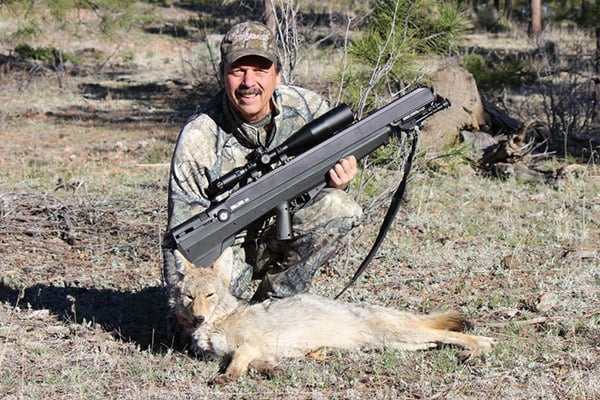
Last Updated on
By Tony Martins
Interest in hunting with airguns is growing. In fact, this is one of the few segments of the hunting industry that is growing, and for good reasons. Airguns are safer and quieter than firearms, they are less expensive to shoot and ammo is readily available, and they can be used in many places where firearms cannot be used. Top-grade precision airguns are now considered to be the most accurate guns in the world… no kidding! High quality adult air rifles are available in calibers from .177 to .50 (and larger in custom guns), and with enough power to cleanly and humanely take all but the largest animals on Earth. Game agencies have taken notice, and many states have updated laws and regulations in the past few years to allow a variety of species to be hunted with airguns, including big game.
I am often asked about hunting with airguns, since I was directly involved in the 2-1/2 year process to expand airgun hunting opportunities in my home State of Arizona. The question asked most often is “how far…?” I’m not sure if this is due to the current long-range “hunting” craze, but it’s important to understand that airguns – like all archery equipment from longbows to crossbows, handguns in handgun calibers, and even muzzleloaders – are limited-range weapons. Thus, the proper emphasis should be on the hunting skill required to get close to the quarry, and the shooting skill required for precise shot placement that is required for these comparatively low-powered weapons to make clean, quick kills. The challenge of taking animals with minimal wounding loss is significant, and one that is not taken lightly by the dedicated airgun hunter.
Two elements are essential for success when hunting with an airgun – accurate shot placement and enough kinetic energy delivered by the projectile to cleanly dispatch animals of the size hunted. A perfectly placed shot will almost always get the job done, even if it is a little under-powered. Conversely, a poorly placed shot with an airgun will often result in a wounded and lost animal, even when more than enough energy is delivered by the shot. Why? Because projectiles launched with compressed air generate substantially less terminal kinetic energy than projectiles launched with gunpowder. Consider the lowly prairie dog for example. This tough little animal is a plague to ranchers and horsemen in many parts of the West. Thousands of these pests are killed every year by varmint hunters using high-powered centerfire rifles like the .22-250 Remington. A 50-grain bullet fired from one of these rifles at 3800 feet-per-second generates over 1600 foot-pounds of energy. This is about 200-times more energy than is actually necessary to kill a prairie dog! Thus, the “kill zone” with this rifle – anywhere on the torso – is about 20 square inches in size due to the tremendous energy delivered, which resultants in hydrostatic shock and of course, blood loss. By comparison, the new Benjamin Armada .22 cal. PCP sporting air rifle – which has quickly become one of my favorites – generates only 32 foot-pounds of energy, or about 4-times more than necessary to cleanly dispatch one of these varmints. Nevertheless, to kill this tough little animal cleanly with this powerful airgun requires a precise shot to the brain, a “kill zone” that is no larger in size than an M&M’s candy! If they are shot in the body and not anchored immediately, many small animals will crawl down a burrow or into thick brush, or some secure location in a tree where they cannot be recovered by the hunter. This illustrates the importance of accuracy when hunting with airguns to avoid unnecessary wounding loss.
Note: A skyline shot should never be taken unless you know that it’s safe. Here, a 600-yard long catch basin full of water lies behind the berm where these prairie dogs live.
Not all airguns are accurate enough, or powerful enough to be used for hunting. In terms of accuracy, the airgun – and the airgun hunter – should be capable of shooting groups of 1-inch or less at the distance that shots at game will be taken. In terms of power, the airgun should generate minimum kinetic energy of 10 foot-pounds to be considered a legitimate hunting weapon. This minimum requirement is adequate for taking animals like rodents, most birds, and small game like squirrels and cottontail rabbits. Larger game requires more energy. Here’s the mathematical formula for kinetic energy: One-half the mass times the velocity squared. A simplified version of this formula for bullets (in grains of weight) that gives a calculated result in units of foot-pounds of energy (fpe) is:
(Bullet Weight) x (Velocity) x (Velocity) / (450,450) = Kinetic Energy in Foot-Pounds
This formula is useful for determining if a particular airgun is suitable for hunting a given animal. Following is a compilation of animals that are often hunted with small-bore airguns (.177, .20, .22 and .25 caliber) with the approximate terminal energy required for a quick, clean kill – field mice and small birds (3 fpe), pigeons and crows (4 fpe), ground squirrels (4-5 fpe), black & brown rats (5 fpe), tree squirrels and cottontail rabbits (5-6 fpe), skunks (6 fpe), prairie dogs and jackrabbits (7-8 fpe), opossums and porcupines (8-9 fpe), woodchucks and raccoons (9-10 fpe), red & gray foxes and wild turkeys (10 fpe), bobcats and coyotes (12-15 fpe). It’s important to understand that these are minimum terminal energy figures for a perfectly placed shot.
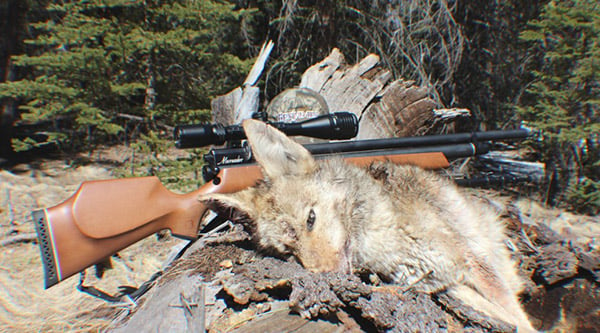
Let’s see what this means in terms of practical application for an airgun like the Benjamin 397 multi-pump pneumatic. This popular air rifle shoots a 7.9 grain .177 cal. pellet at 800 feet-per-second (fps) at full power (8 pumps), generating 11.2 fpe at the muzzle. Now consider that small-bore air rifle pellets are comparatively light in weight and thus will lose as much as 1% of their muzzle velocity for every yard they travel. This means this airgun/pellet combination will deliver only about 5 foot-pounds of terminal energy at a distance of 35 yards, or just enough to cleanly take a squirrel or cottontail rabbit with a perfectly placed shot in the 1-inch diameter kill zone. Obviously, this is the maximum effective distance for hunting these animals with this airgun and projectile. A more powerful air rifle, like the Gamo Whisper Fusion gas-piston, shooting a 9.5 grain .22 cal. alloy pellet at 975 fps, generates 20 fpe at the muzzle and 9 fpe at 35 yards. This additional energy provides a wider margin for error in the event that the shot is not perfect. Stepping up to a .25 cal. pre-charged pneumatic (PCP) airgun like the Benjamin Marauder shooting a much heavier 27.8 grain pellet at 900 fps, produces nearly 50 fpe at the muzzle. This is enough energy to effectively expand the kill zone on a squirrel or cottontail rabbit by 2-3 times – for shots that are a little less than perfect – and to take coyotes out to 50 yards (12.5 fpe) and prairie dogs out to 100 yards (7.5 fpe) with a single shot that is placed precisely.
Note: A skyline shot should never be taken unless you know that it’s safe.
Now let’s revisit the “how far” issue. We know that the maximum range at which animals can be taken humanely with an airgun is limited by two fundamental elements – power and accuracy. We also know that the most effective shot is the brain shot, which kills the animal instantly. Thus, the maximum range for any small-bore airgun is the distance at which a brain (or heart) sized target can be hit on each and every shot, with enough terminal energy to instantly kill the animal hunted. If you do the math you will see that 100 yards is about the limit for the most powerful, precision small-bore airguns in the hands of experienced airgun marksmen, hunting all but the largest and toughest of the small game species (including small predators and varmints).
Big-Bore Airguns
Quoting from Part 1 of this airgun series:“Tough animals, and those weighing more than 50 lbs. require more energy to cleanly dispatch than what is delivered by most “pellet” rifles. This is the domain of the “Big Bore” PCP air rifles, in calibers .357 / 9mm and larger, shooting heavy solid slugs that are more like firearms bullets than the lighter, hour-glass shaped pellets.” Some will argue that anything over .25 cal. is a big-bore, but I consider the .30 cal. air rifles (like the .30 cal. FX Boss and Verminator models, .303 cal. DayState Wolverine, and the .308 Quackenbush Exile) to be in a mid-bore twilight zone of their own, as most are capable of shooting light weight pellets as well as heavier, slugs 150-grains and more. With limited power (velocity) the former acts like a small-bore in terms of energy and penetration into materials like backyard wooden fences, while the latter launched with more power acts like a big-bore in terms of energy and penetration through materials like house walls and car doors. Many states consider airguns up to .25-caliber as safe for backyard use, while larger caliber airguns – regardless of the projectile used – are treated like firearms under laws and municipal ordinances as well as state hunting rules and regulations. Proper use of airguns, particularly big-bores, requires a thorough understanding of the foregoing for each and every area.

Big-bores are the natural progression for airgunners who want to hunt big game. They require a larger volume of air than small-bores to power their larger, heavier bullets. Some models like the new Benjamin .357 Bulldog and Hatsan BT Carnivore in .357 are built with shrouding and/or baffling to quiet their report. Others like the new AirForce Texan .45, and Sam Yang .45 and .50 caliber models are not muffled, and shooting any un-muffled big-bore airgun can be a deafening experience comparable to a magnum firearm. Most big-bores have some type of air regulating device to provide consistent velocity from one shot to the next, so that point-of-impact (poi) is maintained. Some also have selectable power settings to conserve air, and this can be a nice feature on a gun that will be used to hunt both large and small game. Most big game hunters will sight-in their rifles at the maximum power setting for deer and hogs, where air conservation is not an issue. When hunting smaller game and predators with the same gun however, 4-5 lower power shots between air refills would be preferable over 1-2 shots at max power. And, hunting small game with a big-bore airgun allows a little more room for error with shots that are slightly off the mark.
Now you may be thinking that a more powerful airgun is a longer range airgun, right-? Wrong! Even the most powerful big-bore airguns, like the new AirForce Texan .45, or the Quackenbush .458 LA Outlaw (at about 500 fpe each) generate less than 1/6th of the muzzle energy of a typical .30-06 centerfire hunting load (over 3000 fpe)! Despite placing at the higher end of the airgun power scale, these rifles are still limited-range hunting weapons. The heavy bullets (400-grain) and moderate velocities (700-750 fps) of these powerful airguns make it difficult to determine the precise point-of-impact past 100 yards, where the bullet starts to plummet toward earth. Remember, hunting with an airgun – any airgun – is all about precise shot placement. Thus, the limits of the practical range for killing big game like deer and hogs humanely with the most powerful big-bore airguns, is 60-80 yards. Flatter shooting (albeit lower energy) airguns like the .357 Benjamin Bulldog (142 grain bullet @ 750 fps = 175 fpe) and the .30 cal. FX Verminator (45 grain pellet @ 835 fps = 70 fpe) deliver multiple shots (10 and about 30, respectively) in tight groupings from a single full charge of air. Air rifles like these do extend the practical range for smaller animals like predators – but only to about 100 yards.
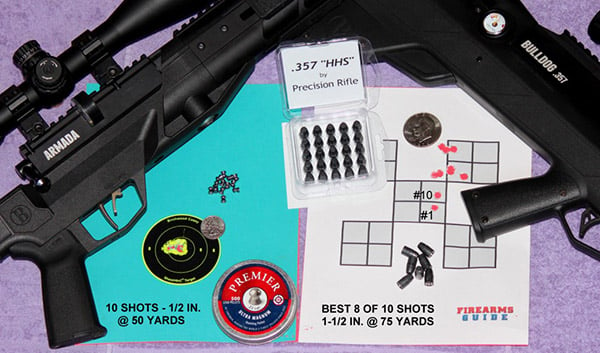
Where To Hunt
Europeans have been hunting with airguns for more than 200 years, primarily for small game with small-bores, while South Africa offers a wealth of big game species for the big-bore airgunner. A little closer to home, more than half the States in the U.S. have hunting opportunities for airguns. Rabbits, squirrels and coyotes are the animals most commonly hunted by airgunners, but rodents and a variety of birds are also popular. Quail are legal game in at least 7 states, including my home State of Arizona, where you will often find elderly airgunners in retirement communities with sights set on some tasty table fare, stationed near bird feeders during the lengthy fall and winter season. Racoons are popular airgun quarry in 16 states, and woodchucks in 8 states. Airgun adventures for uncommon animals would include javelina, coati and ring-tailed cats in Arizona and iguanas in Florida – and what about alligators in Georgia! For big game, try AZ, Michigan, North Carolina or Vermont for black bear, or GA, NC, Ohio, Texas or Virginia for feral hogs. Missouri led the way for hunting native deer with airguns in 2008, and as of this writing 7 additional states (AL, AZ, MI, NC, SC, VT and VA) have followed – each with their own specific regulations and requirements. Texas is absent from this group, but non-native (introduced) sika and axis deer can be hunted with airguns in the Lone Star State, in addition to other exotics like the nilgai antelope. An excellent on-line resource is the State-by-State chart of species approved for airgun hunting that Crosman maintains on their website. Here’s a direct link:
http://www.crosman.com/get-hunting/hunting-resources/state-by-state-species…
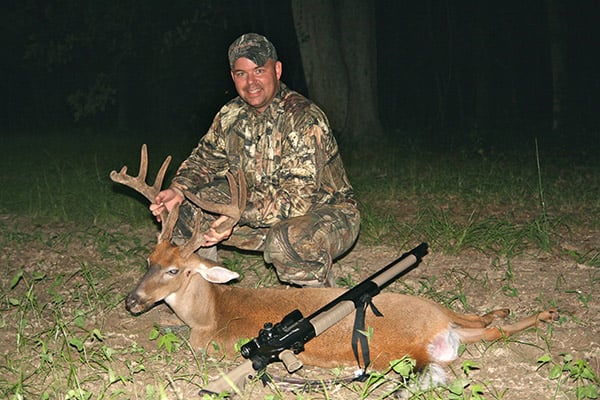
Final Thoughts
I often hear the argument that airguns cannot take big game like deer humanely and therefore, ethically. Protests by anti-hunters and concern over wounding loss (unfounded in my opinion) shot down attempts by airgun enthusiasts in Colorado to expand that State’s airgun hunting opportunities a couple of years ago. A statistic that is often cited is that terminal energy of 800 foot-pounds is necessary to cleanly (humanely) take deer, and this is compared to the energy generated by many big-bore airguns – less than half of this figure. I don’t know the origins of this “statistic” – although it’s often cited by writers in reference to centerfire rifles – but I do know that tens of thousands of whitetail deer have been harvested over the past 200 years with .50-caliber roundballs belched out of primitive muzzleloaders with about the same kinetic energy (179 grain roundball @ 1000 fps = 400 fpe) as the typical big-bore air rifle. I know from experience (1) that if you poke a large hole – like .35-caliber or larger – through both lungs of a deer it may run off, but it will bleed out and die quickly, and (2) that it takes only about 150 fpe for a bullet to pass through both lungs of a deer. I also know for a fact that a shot to the brain of a deer with a bullet packing 150 fpe or more will kill that deer, instantly.
Ultimately, ethical hunting with an airgun or any other weapon is dependent upon the personal ethics of the hunter. I am personally intolerant of wounding loss, which is something I do my very best to avoid. I’m certainly not perfect, but I do spend a great deal of time and effort in working continuously to hone my hunting and shooting skills. Airgun hunting is not for everyone. If you decide to give it a try, here’s a little advice from an experienced airgun hunter: Understand and accept the limited-range capability of your chosen weapon, do your best to get close to each animal you hunt, aim precisely and shoot accurately. If you do, you too will enjoy success and the satisfaction of hunting with a precision airgun.
Disclaimer: A recognized authority on hunting with airguns, author Tony Martins has been involved with airgun field testing for Crosman/Benjamin for the past 3-1/2 years. Although he strives for impartiality, many of the airguns he currently owns were manufactured by this company.

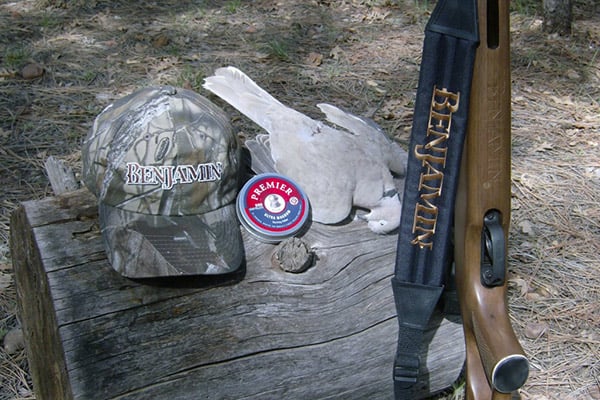
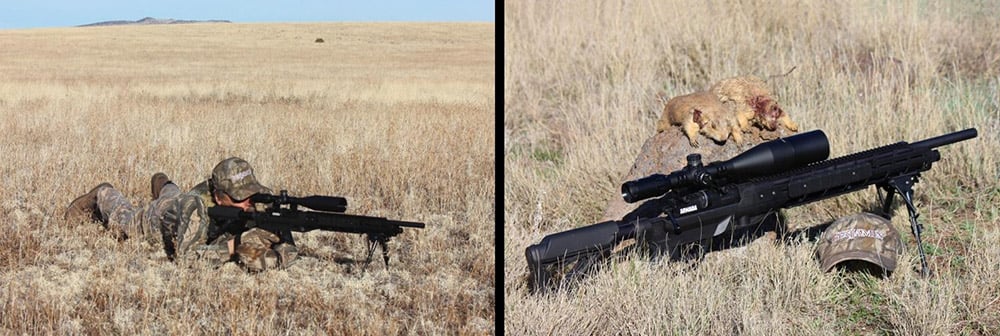




Comments (1)
Richard Speightssays:
July 13, 2015 at 1:54 pmInteresting…that’s for the information.